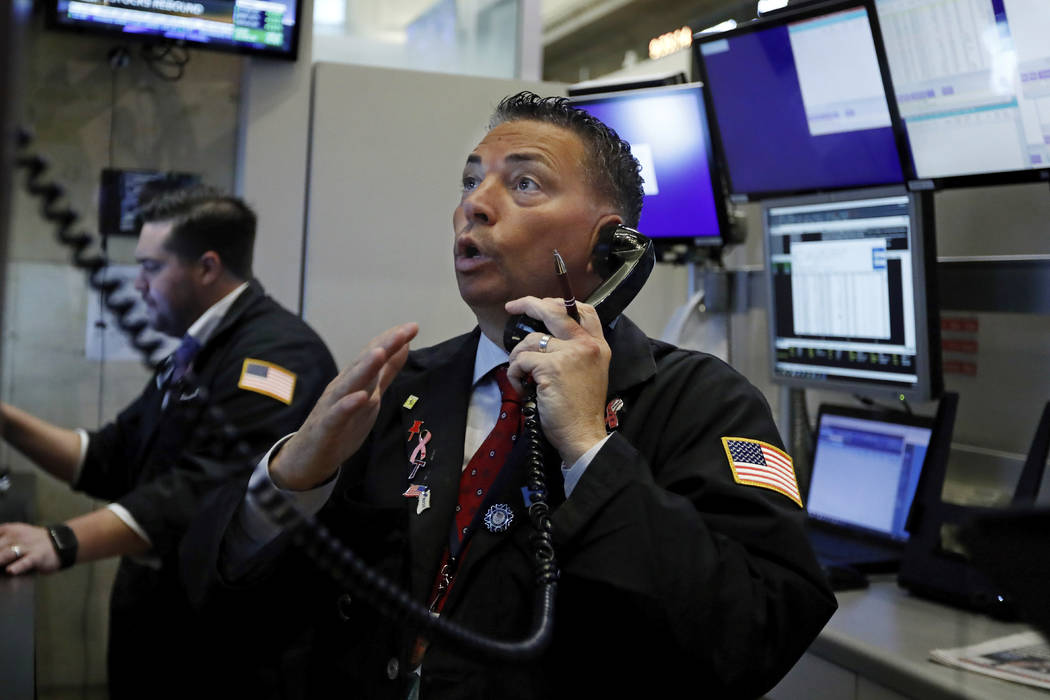Stocks, bonds slide amid widespread fear of economic slowdown
Stocks fell in afternoon trading on Wall Street Wednesday as fears that an escalating trade war between the U.S. and China may stifle global economic growth. Investors sought shelter in bonds, gold and other safe-haven holdings.
Bond yields sank around the world, something that happens when investors see a weaker economy and low inflation on the way. Gold prices jumped to the highest price in more than six years.
Financial sector stocks led the way lower, even after a furious morning sell-off that knocked the Dow Jones Industrial Average down more than 580 points eased by midafternoon.
The market has been roiled the past couple of weeks by growing anxiety as the U.S. and China clash over trade.
Last week, President Donald Trump rattled markets when he promised to impose 10% tariffs next month on all Chinese imports that haven’t already been hit with tariffs of 25%. China struck back on Monday, allowing its currency, the yuan, to weaken against the U.S. dollar.
China stabilized the yuan on Tuesday and that helped lift U.S. stocks a day after they endured their worst day of the year. But the markets turned volatile again after central banks in New Zealand, India and Thailand cut key interest rates Wednesday.
Treasury yield at 3-year low
The surprise interest-rate cuts triggered a slide in bond yields around the world as investors scrambled for safety.
The yield on the 10-year Treasury dropped to its lowest level in nearly three years, down to 1.67% from 1.74% late Tuesday, and it’s been sliced nearly in half in just nine months.
“The Treasury market is trading much higher … as investors continue to seek a safer haven, completely unsure as to what may happen next,” Kevin Giddis, head of fixed income capital markets at Raymond James wrote in a report.
The S&P 500 index was down 0.2% as of 11:13 p.m. Pacific time. The Dow slid 85 points, or 0.3%, to 25,946. It was down as much as 589 earlier. The Nasdaq shook off an early slide, edging up 0.2%.
The volatile trading has put a dent in the major indexes yearly gains. The S&P 500 is down 3.5% for August.
The market’s turbulent turn comes less than two weeks after the benchmark S&P 500 hit an all-time high.
Economy doing well
While investors have been scrambling to adjust to the turns in the trade conflict, the broader U.S. economy continues to grow and add jobs. Unemployment is at the lowest level in decades and consumer confidence remains strong.
Corporate earnings, meanwhile, have been coming in better than expected.
Still, the bond market continues to flash a warning signal of recession. The gap between the yield on the three-month Treasury and the 10-year Treasury widened even further. It’s a rare occurrence because investors usually demand bigger yields for tying up their money for longer periods of time, and one rule of thumb says a recession may hit about a year afterward if the gap, or spread, between those two rates persists over a long period.
A three-month Treasury was yielding 0.36 percentage points more than a 10-year Treasury as of Wednesday afternoon. The margin hasn’t been that big since the spring of 2007, less than a year before the Great Recession torpedoed the economy.
Investors are increasingly betting that the Federal Reserve will need to cut short-term interest rates to support the economy given all trade tensions, and traders see a 55% chance of three cuts or more by the end of the year. A month ago, they projected the probability of that at less than 9%.
A wild 19 months
U.S. stocks have been on a wild ride since Jan. 22, 2018, when Trump first imposed tariffs on solar products and washing machines to help U.S. manufacturers, but they’re virtually back to where they started.
The S&P 500 closed at 2,832.97 that day and has since been down as much as 17% and up as much as 7%, with moves often driven by waxing and waning worries about the trade war. On Wednesday morning, the S&P 500 sat at 2,862.45, up 1% from that early 2018 starting point.
Since Trump tweeted in March 2018 that “trade wars are good, and easy to win” after raising tariffs on steel and aluminum, the S&P 500 is up 6.3%, though that gain has nearly halved in the last couple weeks as worries about the trade war have surged.
Banks sustained some of the worst losses Wednesday. Lower bond yields mean lower interest rates on mortgages and other kinds of loans, which mean lower profits for banks. JPMorgan Chase fell 2.8% and Bank of America fell 2.7%.
The dimming expectations for global growth also send the price of crude oil sharply lower. Benchmark U.S. crude plunged 4.6% at $51.16 a barrel. That helped pull energy sector stocks lower. Occidental Petroleum gave up 4.9%.
Safe-play stocks, including consumer staples and utilities, held up far better than the rest of the market.
European and Asian indexes were mixed.
Disney drops, CVS gains
Disney fell 5.2% after disappointing investors with a sharp third quarter profit plunge that fell far short of Wall Street forecasts. The entertainment company said underperformance from its Fox movie and TV studio helped weigh down the fiscal third quarter financial results. It bought Fox’s entertainment business in March for $71 billion.
Match Group shares jumped 25.4% after the operator of Tinder, OKCupid and other dating sights beat Wall Street’s second quarter earnings forecasts. The company reported a surge in Tinder subscribers and raised its revenue forecast for the year.
Drugstore operator CVS Health rose 6.6% after swinging to a second quarter profit and handily beating Wall Street forecasts. The company attributed part of the gains to health insurer Aetna, which it bought for $69 billion in November.






















